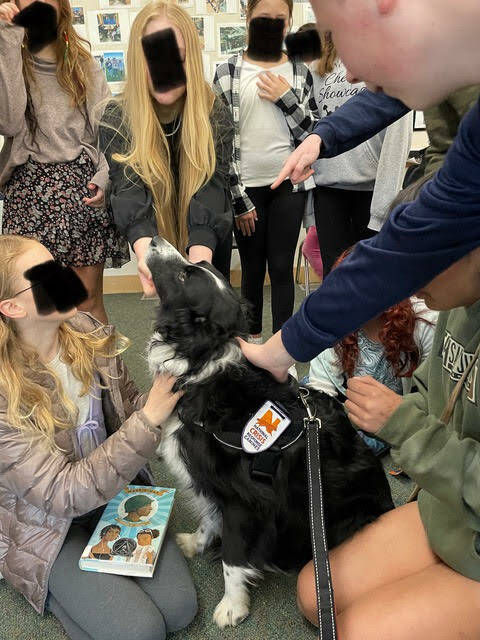A border collie, Jet, lay calmly at her feet while she recounted her trauma in court. It is his job to be there for people stressed, and in crisis, be the healing balm they need to overcome and persevere.
“My motivation is for Jet to work. He is just magical. He really leans in and makes these connections,” Jet’s handler Cynthia Parkin explained.
San Juan County currently has four trained and certified crisis response canines. Three others, Ruffles, Pickles and Bungee share Raquel Lackey as their handler.
According to Parkin, crisis response canines are not service dogs or therapy dogs. They are a higher level of therapy dog vetted, trained and certified. It is imperative that the dog want to do the work, and responds to a crisis scene calmly.
“They have to show they want to do the work and can handle big emotions,” Parkin said.
“Lackey echoed that sentiment explaining various ques her dogs give her that show they are, for whatever reason, not up to the task at that moment.
“Pickles is subtle. She will look away or put her head down, pause at the door just a little,” she explained. “Some dog’s tail tuck, lower their eyes sniff the ground excessively.”
The six-year-old Jet was trained in Alaska under the National Crisis Response Canine program, while Lackey and her animals were trained at the Hope Animal Assisted Crisis Response. Both are similar and allow them to respond to crises across the nation. The two are just different schools.
According to Parkin, the training is largely geared toward the handler to ensure they pick up on those cues, subtle or not.
“My job is to keep Jet healthy, make sure Jet does not experience secondary trauma. I take his lead. When it’s really an emotional situation, I take his lead, to be centered to lean in,” Parkin said. “When someone is crying we often hand them a tissue. That signals to stop when [the person] really needs to grieve.”
Jet was in the process of his certification when the pandemic hit, which delayed his training slightly. Also during that time period, Parkin moved to the San Juans. She reached out to first responders like the sheriff’s office and fire department. Chief Norvin Collin was thrilled, and even brought in Lackey and her dogs a short time later.
“You can see the impact right away,” Collins said. During a training last year, two trainees’ vitals, like heart rates, were high and not coming down, even after mindful breathing exercises. Jet came over and within minutes the trainees showed improvement.
“We would not have been able to complete the training without him,” Collins said. “So not only are they beneficial during and post-crisis, but also prior as the canines reduce Post Traumatic Stress.”
Taking reducing stress one step further, Collins said the department has been practicing Mindful Monday to reduce the attitude many first responders have, “We help others, we don’t need help”
It takes a lot to put out a fire or respond to any crisis, Lackey pointed out. Oftentimes responders don’t realize the toll it has taken on their body or mind.
“The members will take the time with the dogs when Cynthia or Raquel stop by. I had someone tell me ‘I never realized I was struggling during the day until the dog came over. Once I started petting it, when I went home I felt better.’ The dogs are amazing how they can pick up on cues.”
Lackey added the stress first responders may feel toward the end of their careers.
“You have been driving hard, going going going, and at the end it all comes crashing down. We want to prevent that,” Lackey explained.
Collins also told the story of when firefighters responded to a fire where an individual had lost their support animal in the fire. The victim was grieving and Jet was able to provide comfort.
“It’s hugely beneficial to the community,” Collins said, emphasizing that these dogs are not arson or law enforcement animals but for crisis response.
Jet has frequently been visiting the Sheriff’s Office as well, giving dispatchers and deputies a chance to destress if they have had a particularly rough day. The first responders may interact with the canines as much or little as they like, and Collins pointed out that the dogs may visit Orcas, Lopez first responders if they are needed
Lackey and her dogs also appear at the Library for Reading with Rover, helping kids learn to read. “Covid devastated the county, and kids suffered too. They are currently way behind in reading.”
Reading with Rover works in part by using the same calming, non-judging energy that assists people in crisis.
“Kids will read to a dog because they know the dog wont be judgemental,” Lackey said. The canine also serves to calm the child should they feel anxious while reading. The youth are given stickers of the dog and bookmarks with their paw print. Both Lackey and Parkin would like to see an increase in canine crisis response at the schools if for no other reason than to great the children.
“We don’t just want to bring the dog teams in when the bad stuff happens, but when there is good stuff to celebrate too,” Lackey said.
More crisis dogs are going through the process of being trained in crisis response.
“I want to grow the program. It’s all volunteer and I can’t do it all,” Parkin said. ‘There are three new pairs working through the training but there is no guarantee they will become certified.”
For anyone interested, visit HOPE at https://www.hopeaacr.org/ or National Crisis Canines at https://crisisresponsecanines.org/.



